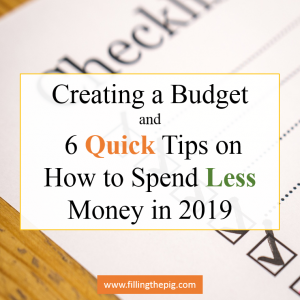As with most Americans, a new year brings new resolutions. One of the most common resolutions every year surrounds the topic of personal finance. Recent surveys suggest that 34% of the New Year resolutions made will be about the desire to spend less money and save more. Changing our spending habits in the New Year ranks third behind self-improvement and weight-related resolutions.
Since Filling The Pig is all about personal finance, I thought I would take the opportunity to provide some helpful tips on ways to spend less and save more cash. Here’s how to spend less money in 2019.
Re-evaluate Your Budget
Personally, I have always used the start of a new year as an opportunity to re-evaluate my monthly budget and review my savings and investments. Are they on track? Are they off track? Did I spend more than expected? Re-evaluating my finances allows me to re-affirm that I am headed in the right direction (or wrong) in terms of my personal finance goals.
Do you have a budget? A plan? How about creating a budget in 2019? As discussed in my eBook Filling The Pig, creating a budget is a serious first step to spending less, eliminating debt, and saving cash.
For most, the thought of creating a budget can cause fear, anxiety and a whole bunch of other negative emotions (kind of like going to the dentist). However, creating a budget allows you to understand where you spend your money and why you are spending it. Once you understand your spending habits, reducing expenses and saving more becomes an easy task. FTP recommends creating a budget and following it for three months. After three months you will find you have a much better understanding of where your money goes and where you can save.
If you are serious about changing your spending habits in 2019, download my free Workbook. The workbook will provide you with a step-by-step procedure for establishing your budget and provide a means of tracking your daily expenses.
Related Posts:
- What You Shouldn’t Do with Your Holiday Credit Card Debt.
- Three Reasons to Budget Your Money and It’s Not Because You Will Save More Money
- Budgeting Questions: Your Home or Car?
- How to Pay Off Credit Card Debt Using The Snowball Method (video)
- My Review of the Ebates Cash Back Program
Once you establish your budget, you’re now ready to save.
Six Quick Ways to Reduce Expenses, Save Cash and Spend Less Money
1. Start contributing to your employers 401 (k) plan or open a Traditional IRA account. Both of these retirement accounts are an indirect way of saving money by reducing your taxes. Contributions to a 401 (k) plan or a Traditional IRA account lower your taxable income. In addition, they provide an investment vehicle so you can start saving for retirement.
Estimated monthly savings – varies depending on income level and contribution to other retirement accounts. You can review the IRS contributions limits here.
To learn more about 401 (k)s and Traditional IRA accounts be sure to read: 3 Reasons You Should Contribute to Your Employers 401 (k) Plan and Lower Your Taxes and Start Investing by Opening a Traditional IRA Account.
2. Get Rid of Cable. The average cable bill in the United States is $103. Depending on your plan you could be paying more. Either way, it’s a quick method of lowering your monthly expenses immediately. Replace the cable with traditional FREE local channels (you know, old school antenna – this is the model I use) and/or supplement with Internet streaming services like Amazon Prime, Netflix or VUDU.
Estimated monthly savings – $80.
3. Dine Out, Less. Americans are notorious for eating out every chance they get. The average American spends around $200 per month. The average lunch or dinner costs $12.75. Not only is eating out more expensive, in most cases it’s not healthy. Eat out half as much, treat yourself to a healthy home prepared meal and you will recognize immediate savings.
Estimated monthly savings $100.
4. Heating and Cooling. Heating and cooling costs make up about 50% of your total utility bill. Some quick ways to reduce those costs include:
- Adjusting the thermostat down in the winter. In general, you can save 1-3% on your heating bill for each one degree of temperature reduction. Turn your thermostat down at bedtime to realize the most significant savings. (Throw an extra blanket on.)

- Change out that old thermostat. If you live in an older home with a manual thermostat, changing the thermostat out to a programmable digital thermostat could save you as much as 20% on your heating and cooling costs. The greatest advantage digital thermostats provide is they allow you to automatically manage your temperature settings when you’re not there. Depending on the model, digital thermostats can run $25-$50. If you are a do-it-yourselfer you can easily install these on your own.
- Window insulation kits. Savings vary depending on the age of your windows and the number of windows you have. On the farm, I have easily saved 30% on my heating costs over the course of the Wisconsin winters. Window kits are easy to install and can be removed in the spring.
Estimated monthly savings $30-$50.
5. Shop Your Vehicle Insurance. In general, most of us stay with the same insurance company year after year, and we often don’t make changes to our policy. One way to spend less money is to re-evaluate your coverage options including your deductible. Got cash? Remember cash is about creating opportunities. If you have established an emergency fund (See Cash Ladder), and have additional cash in the bank then you have the opportunity to increase your deductible which in return will lower your premium. You can evaluate your current insurance rates by getting a quick quote through Esurance.
Estimated monthly savings $15-$20.
6. Use Cash. Similar to establishing a budget, using cash instead of a debit card or checks makes you more aware of your buying decisions. Paying with cash makes you conscious of your decisions and is a great way to change your spending habits. Simply by using cash, you will easily save 15-20% on your current budget.
Estimated monthly savings $40-$60.
Total estimated monthly savings $310, that’s Filling The Pig
Start 2019 out on a high note and spend less money. Everyone’s situation is different, but there are literally hundreds of other methods for reducing expenses and saving cash on a monthly basis. However, nothing will change your spending habits faster and allow you to recognize areas to reduce expenses then creating a budget. Establishing a budget isn’t just about the money, it’s also about changing your spending behaviors for the long term. And understanding your circumstances for spending less money and saving more.
Helpful Resources:
- Recommended Products from Filling The Pig
- Credit Sesame Credit Monitoring
- Cut Cable with a Sony Streaming Media Player
- Ebates – earn cash back by purchasing the things you were going to buy anyway.
Sign up for a Kindle Unlimited Free 30 Day Trial and read the complete Filling The Pig finance series of books for free.



I use LeanFinancial.com to help me save. It’s a free budgeting tool that organizes future expenses into equal monthly savings installments. Deposits can then be placed in guaranteed fixed-rate investments generating revenue until needed for the purchase, lowering the installment.
Thanks Brendan for the tip and providing another means for budgeting, saving and investing.